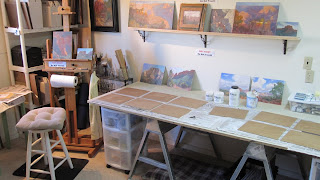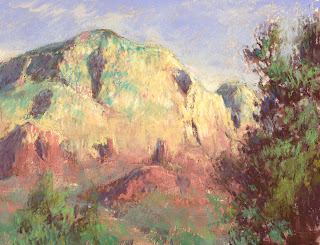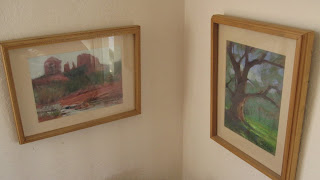 |
| Into the Flow, 12x16, oil |
I like to paint, but I don't like to frame. For me, framing is a completely different craft. In my mind, anything that has to do with framing - all the way from simply picking out a ready-made to building your own frames - has nothing to do with the craft of painting.
We've all been told that, in a buyer's mind, a nicely framed painting is the complete package. A painting without a frame is incomplete. It's like buying a custom car without the paint job and chrome. I want to be the mechanic who builds the engine and the car's other important systems, but I'd love to leave the chrome and color choices to someone else.
Of course, I can't do that. I can sell my demos and sketches unframed, but any finished painting really needs to go in a frame to look, well,
finished. (Gallery-wrapped paintings always look unfinished to me.)
There are two problems with framing. First, although there are some basic principles that govern framing, framing is a personal choice. For my oil paintings, I like simple "plein air" frames, either gold or silver, or black with a little gold or silver fillet. I put gold on paintings that are dominantly warm, silver on ones that are dominantly cool, and black, of course, goes with most anything. A 3-inch moulding works for 9x12s on up to 16x20s. For my pastel paintings, I still use a mat, though I've started going toward matless framing. My color choice principles still apply.
But I have buyers who come to my gallery who are adamantly opposed to gold - or to silver, or to black. If I have a frame in stock that they prefer, I'll reframe the piece accordingly. But I'm not a frame shop, so if they want something I don't have - maybe an ugly Rococco frame with plaster epaulettes and genuine gold leaf - I offer to remove the frame and deduct my cost. This always satisfies the buyer.
The second problem is expense. Good frames aren't cheap. You can buy cheap ones, but they are always cheaply made with inferior materials. I've bought cheap frames, and most of them are made of composite and wood filler that chips and dings far too easily. I like frames made of real wood. Still, there are places where you can get good frames that don't cost too much. (
www.classicgalleryframing.com is one.) I also look for sales on ready-mades. As much as I like to support the local guy, it's usually more expensive to go to a framer and have something custom-made. But they do know what they're doing, and sometimes they'll make you a deal if they have some extra moulding left over from a special order.
Often, you can find beautiful frames for not very much at yard sales. The painting at the top of this post is one such frame. It's not a frame I would have bought, but I really like it for this painting.



































